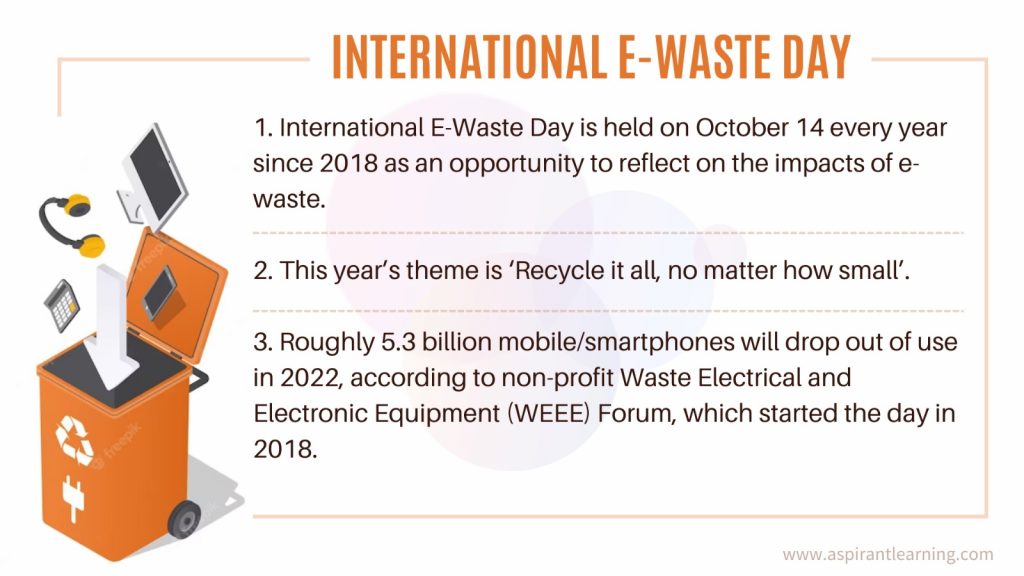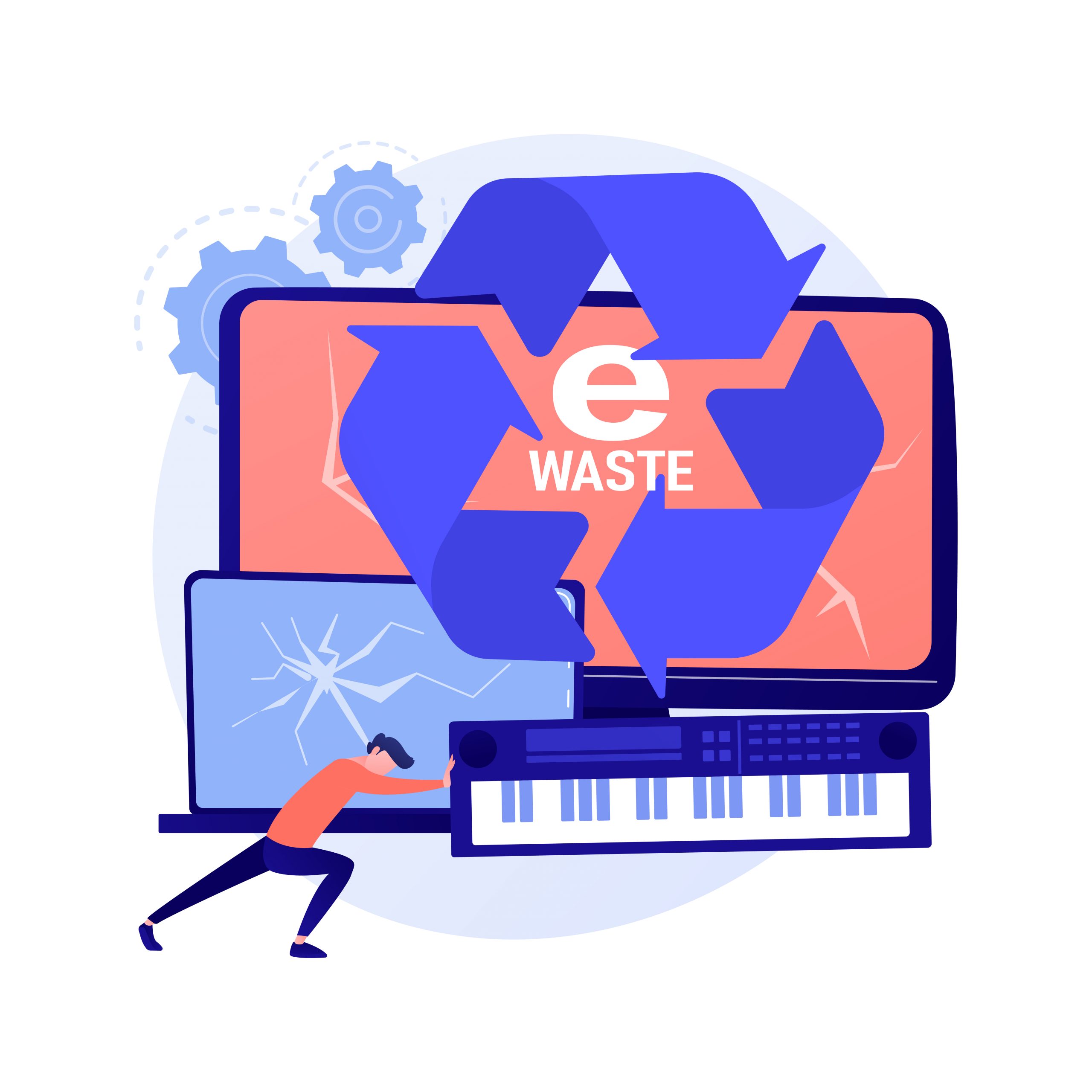News Highlights:
In November 2022, The government notified E-waste (management) rules 2022, where the informal sector, which is crucial to processing e-waste, receives no recognition under the new regulations.
E-waste rules:
- Background:
- The first set of e-waste Rules was notified in 2011 and enacted in 2012.
- An important component of the Rules (2011) was the introduction of Extended Producer Responsibility (EPR).
- Under EPR compliance, ‘producers’ are responsible for safely disposing of electronic and electric products once the consumer discards them.
- E-waste (Management) Rules, 2016 was enacted in 2017
- In November 2022, the Ministry of Environment and Forests further notified a new set of e-waste rules
- About E-Waste Rules 2022:
- The E-Waste (Management) Rules, 2022 was published by the Ministry of Environment, forest and climate change on November 2, 2022.
- The new rules will come to effect from April 1, 2023.
- They will apply to all businesses and individuals involved in manufacturing, sales, transfer, purchase, refurbishing, dismantling, recycling and processing of e-waste or electrical and electronic equipment.
- E-waste items:
- Under the new rules, the number of items that have been categorised as e-waste has increased from 21 to 106.
- It includes all electrical devices and radiotherapy equipment, nuclear medicine equipment and accessories, Magnetic Resonance Imaging (MRI), electric toys, air conditioners, microwaves, tablets, washing machines, refrigerators, iPad and others.
- This includes electronic components, consumables, parts and spares that make the electronic products operational.
- The new rules do not apply to waste batteries covered under the Battery Waste Management Rules, 2022.
- It is also not applicable for packaging plastics covered under the Plastic Waste Management Rules, 2016.
- It also does not apply to micro-enterprises and radio-active wastes covered under the Micro, Small and Medium Enterprises Development Act, 2006 and Atomic Energy Act, 1962, respectively.
Highlights of e-waste rules:
- Restrictions of hazardous substances:
- The government has restricted the use of hazardous substances in manufacturing electrical and electronic equipment (EEE) following deaths due to exposure to radioactive material.
- It mandates reducing the use of lead, mercury, and cadmium, among others, in electronic equipment manufacturing.
- Reuse and recycling:
- Manufacturers shall use the technology or methods to make the end product recyclable and shall ensure that components or parts made by different manufacturers are compatible with each other to reduce the quantity of e-waste.
- Strict monitoring:
- The Central Pollution Control Board shall conduct random sampling of electrical and electronic equipment placed on the market to monitor and verify the compliance of reduction of hazardous substances provisions.
- If a product does not comply with the e-waste management rules, the manufacturer must withdraw all samples from the market.
- Extended Producer Responsibility Certificates:
- Draft rules aim to incentivise registered electronic waste recyclers by introducing EPR or Extended Producer Responsibility certificates (which were not part of the 2016 Rules).
- E-waste exchange facilities:
- The EPR requires producers to set up e-waste exchange facilities to facilitate collection and recycling and assign specific responsibility to bulk consumers of electronic products for safe disposal.
- Imports:
- Imports or placement in the market for new electrical and electronic equipment shall be permitted only for those which are compliant with provisions laid down by the government.
- Disposal:
- It is the responsibility of the manufacturer to collect e-waste generated during manufacture and to ensure its recycling or disposal.
- However, the rule does not apply to waste batteries, packaging plastics, micro-enterprises and radio-active waste, as covered under the provisions of the law.

Challenges Related to E-Waste Management:
- Less Involvement of People:
- A critical factor in used electronic devices not being given for recycling was because consumers themselves did not do so. However, countries worldwide have been attempting to pass effective ‘right to repair’ laws in recent years.
- Involvement of Child Labor
- In India, about 4.5 lakh child labourers in the age group of 10-14 are engaged in various E-waste activities without adequate protection and safeguards in various yards and recycling workshops.
- Ineffective Legislation:
- There is the absence of any public information on most State Pollution Control Boards (SPCBs)/PCC websites.
- Health Hazards:
- E-waste contains over 1,000 toxic materials contaminating soil and groundwater.
- Lack of Incentive Schemes:
- No clear guidelines exist for the unorganised sector to handle E-waste. Also, no incentives are mentioned to lure people into adopting a formal path for handling E-waste.
- E-waste Imports:
- Cross-border flow of waste equipment into India– 80% of E-waste in developed countries meant for recycling is sent to developing countries such as India, China, Ghana, and Nigeria.
- The Reluctance of Authorities Involved:
- Lack of coordination between various authorities responsible for E-waste management and disposal, including municipalities’ non-involvement.
- Security Implications:
- End-of-life computers often contain sensitive personal information and bank account details, which, if not deleted, leave an opportunity for fraud.
Way Forward:
- Various startups and companies in India have now started collecting and recycling electronic waste.
- We need better implementation methodologies and inclusion policies that provide accommodation and validation for the informal sector to step up and help us meet our recycling targets in an environmentally sound manner.
- Also, successfully raising collection rates required every actor to be involved, including consumers.
Pic Courtesy: Freepik
Content Source: The Hindu



